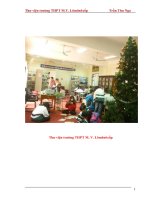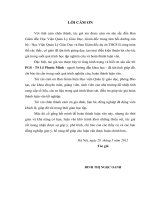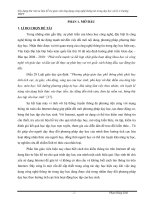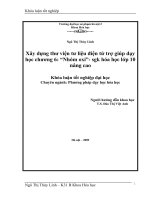phố cổ mỹ thuật đào thị nhung thư viện tư liệu giáo dục
Bạn đang xem bản rút gọn của tài liệu. Xem và tải ngay bản đầy đủ của tài liệu tại đây (144.34 KB, 11 trang )
<span class='text_page_counter'>(1)</span><div class='page_container' data-page=1>
Date of preparation : ………..
Date of teaching: …………..<b> </b>
<b>Period : 7 </b>
<b> UNIT 2</b>
<b> </b>
<b>AT SCHOOL</b>
<i><b> Lesson 1 -Section: A(1-4) - COME IN </b></i>
<b>I/Objectives</b>
:<b> </b>
By the end of the lesson, Ss will be able to use classroom imperative to
understand teacher’s commands.
<b>II/ Teaching methods:</b>
- The audio lingual method, communicative language teaching method
- Asking and answering, pair work, group work, guessing, noughts and crosses
<b>III/Teaching aids: </b>
<b>-</b> Flash cards, pictures, realia, cassette, tapescript
<b>IV/ teaching procedures</b>
<b> A.Class organization</b>
- Greeting
- Checking student’s attendance: 6C ………..
<b> B .</b>New lesson
<b>Teacher s and Students activities</b>’ ’
<b>1. Warm up:</b>
- T sticks the table on the board.
-Guide Ss to play the game. (Ss give answer
only).
+plus: cộng.
+multiply: nhân.
+subtract: trừ.
<b>2. Presentation</b>
<b>.</b><b> </b>
-Introduce some new words.
-Read new words aloud
- Ss repeat.
-Ss read individually.
*Checking: Rub out and remember.
- Read the text aloud
- Ss : Repeat
Read in Chorus
Read individual
<b>3. Practice .</b>
-Ask Ss to look at the pictures /21 and match
each picture with the correct word or phrase
word.( work individually).
-Give answer key.
<b>Contents</b>
<b>* Noughts and Crosses. </b>
9-5 20-7 10-2
17+1 6+5 8+4
3-3 6x3 5+3
<b>1. Vocabulary:</b>
- come: (v) (pict. ).
-sit down >< stand up: (v)
(action).
-book: (n) (realia).
-open your book: (act).
close your book: (act).
<b>2.Presentation</b>
<b> </b>
<b>a. T</b>
<b> ext </b>: A 1/ 20.<b>3. Practice: Matching.</b>
a. Open your book.
b. Sit down.
</div>
<span class='text_page_counter'>(2)</span><div class='page_container' data-page=2>
- Give the formation of imperative
-T mimes: (open your book, sit down, stand up,
come in, close your book)
-Guide Ss to play the game.
<b>-T: stand up. Ss don’t do</b>
-T: Simon says stand up. Ss do.
<b>4. Production: </b>
-Let Ss make the dialogue by using the mapped
dialogue
- Ask Ss to do the exercise.
<b>5. Homework:</b>
d. Close your book.
e. Stand up.
<b>*Structure</b>
: Imperative
<b> From: V + O /A</b>
Ex: Open your book.
<b>4 .Mine Drill:</b>
Students say:
+Open your book.
+Sit down.
-etc.
<b>5. Simon says.</b>
<b>6.Further practice</b>
:
<b>* Mapped dialogue</b>.
Miss Hoa Children
... morning
How...?
Fine ..., sit...
and open...
...morning
Miss Hoa
We’re ...
How...?
Yes, Miss!
Yes, miss!
*Put the correct word in the
brackets.
a. ...down, please.
b. ...your book.
c. ...notebook, please.
d. ...up, please.
e. ...in
- Learn structures and dialogue by
heart.
- Do exercise in workbook.
- Prepare next part B 1,2
Date of preparation : ………..
Date of teaching : ………...
<b>Period : 8</b>
<b> UNIT 2</b>
<b> AT SCHOOL </b>
<i><b> Lesson 2 -Section B(1-2) -WHERE DO YOU LIVE ?</b></i>
<b>I/ </b>
</div>
<span class='text_page_counter'>(3)</span><div class='page_container' data-page=3>
By the end of this period, the students will be able to use “ Where do you
live ?” questions and answers to talk about the places you live.
<b> II/ Teaching methods:</b>
- The audio lingual method, communicative language teaching method
- Hang man , noughts and crosses, pair work & group work , Role play
<b>III/Teaching aids: </b>
<b>-</b> Flash cards, pictures, realia, cassette, tapescript
<b>IV/ teaching procedures</b>
<b> A.Class organization</b>
- Greeting
- Checking student’s attendance: 6C ………..
<b> B .</b>New lesson
<b>Teacher’s &students’ activities</b> <b>Content</b>
<b>1. Warm up</b>
- Have Ss play game “ Hang man “ with
words : sit down , stand up, open your
book, …
<b>2. Presentation</b>
- Introduce some new words
Ex: We live in Viet Nam
Ex: We live in Buon Ma Thuot City.
- Read new words aloud s
- Ss: - Repeat
- Read in chorus
- Read individual
- Copy in their notebooks
* Check Vo. What & Where
- Read the dialogue aloud
- Ss:- Listen
<b>* Hang man </b>
<b>1.New words:</b>
1. (to) live (example)
2. a house (picture / draw)
3. a street ( picture )
4. a city (example)
5. What (trans. )
6. Where(trans.)
7. How(trans.)
<b>2. Presentation Dialogue </b>
( B1 – P.23)
</div>
<span class='text_page_counter'>(4)</span><div class='page_container' data-page=4>
- Repeat
- Play the role to practice
- Introduce the new structures
Note : Tiếng Anh Mỹ (AE) dùng giới từ <b>on</b>
trong cụm từ <b>live on + location.</b> Ví dụ : I
live on Cau Giay Street, nhưng tiếng Anh
Anh (B E ) dùng giới từ <b>in </b>trong trường
hợp này .
<b>3. Practice </b>
- Model 2 cues , the whole class repeats,
then ask some students to repeat
individually
- Make sure the students remember the
exchange, then ask a new student / give a
new cue.
- Let all students work in pairs, one asks ,
the other answers
- Stick this chart on the board and have Ss
play the game.
<b>4. Production</b>
- Have each student asks and fills in
information about three others
<b>5. Homework:</b>
A: Where do you live?
B: I live <b>on</b> <b>Tran Phu Street</b>.
in a house
a city
Hue
Vietnam
<b>3. Pratice:</b>
<b> </b>
<b> * </b>
<b>) Word cue drill</b>
a house <b>a city</b> BMT
City
Le Duan
Street
<b>Le Loi </b>
<b>street</b> Hue
Example Exchange:
S1: Where do you live?
S2 : I live <b>on Le Loi Street</b>
<b>*) Noughts and Crosses </b>
Trang Tien a city a house
Long Xuyen Da Nang Dong Hoi
a street Vietnam Y Jut Street
<b>* Survey</b>
Name Street City
- Learn structures and dialogue by
heart.
- Do exercise in workbook &
Prepare next part B 3,4
</div>
<span class='text_page_counter'>(5)</span><div class='page_container' data-page=5>
<b> AT SCHOOL </b>
<i><b> Lesson 3-Section B(3-5)</b></i>
<i><b>-WHERE DO YOU LIVE?</b></i>
<b>I/ </b>
<b> Objectives</b>
By the end of this period, the students will be able to use the questions: “
What’s your name?” and “ How do you spell it?” with the alphabet (a-z) to talk
about your name.
<b>II/ Teaching methods:</b>
- The audio lingual method, communicative language teaching method
- Pair work & group work , Role play
<b>III/Teaching aids: </b>
<b>-</b> Flash cards, pictures, cassette, tapescript
<b>IV/ teaching procedures</b>
<b> A.Class organization</b>
- Greeting
- Checking student’s attendance: 6C ………..
<b> B .</b>New lesson
<b>Teacher’s &students’ activities</b> <b>Content</b>
<b> 1. Warm up </b>
.- Sing
- Ss: listen
<b>2. Presentation</b>
- Introduce new words
Turn on the tape ( 3 times ) –B 3
- Ss listen & repeat.
- Read individual
T: correct the mistakes.
- <b>* Check Vo: </b>Have Ss play game “Shark
attack” with some words such as: house,
open, close, street, goodbye
- Read the dialogue aloud
- Ss:- Listen
- Repeat
- Introduce the new structures
-Explain the way to use questions:
* Sing “ The A, B, C” song
<b>1. New words:</b>
1. (to) spell ( trans. )
a, b, c, d, e, f, g
h, I, j, k, l, m, n
o, p, k, r, s, t, u
v, w, x, y, z
<b>2. Presentation Dialogue </b>
( B4 – P.25)
<b>* Model sentences:</b>
</div>
<span class='text_page_counter'>(6)</span><div class='page_container' data-page=6>
“ What’s your name?” and “ How do you
spell it?”
- Note the way to read “spell-it” and
What’s_ your ... .
- Have Ss play the role to practice
<b>3. Practice </b>
- Model 2 cues , the whole class repeats,
then ask some students to repeat
individually
- Make sure the students remember the
exchange, then ask a new student / give a
new cue.
- Let all students work in pairs, one asks ,
the other answers
4. Production
- Divide the class into 2 teams.
- Write 10 numbers on the board ,
Tell Ss each number is for a question but
three of them are lucky numbers . If Ss
choose a lucky number , they do not need
to answer any question but they get 2
points and they can choose another
number.
- Let Ss play the game
<b>5. Consolidation and homework:</b>
A: How do you spell it?
B: L – A – N , Lan.
<b>3. Practice:</b>
<b>* Word cue drill</b>
Minh Nga Hue
Ngan Quynh Huyen
Example Exchange:
S1: What’s you name?
S2 : My name ‘s Minh
S1: How do you spell it ?
S2 : M-I-N-H, Minh.
*Lucky number
1 2 3 4 5
6 7 8 9 10
*- 1 ,5,7 are lucky numbers
2. What’s your name?
3. Spell from Z to A
4. Where do you live?
6. How do you spell your name?
8. How old are you ?
9. How are you?
10. Spell from A to Z
- Learn structures, the alphabet and
dialogue by heart.
- Do exercise in workbook &
Prepare next part C
Date of preparation : ………
</div>
<span class='text_page_counter'>(7)</span><div class='page_container' data-page=7>
<b> UNIT 2</b>
<b> AT SCHOOL </b>
<i><b> Lesson 4 - Section C(1) - MY SCHOOL </b></i>
<b>I/ </b>
<b> Objectives</b>
By the end of this period, the students will be able to
- learn how to say what thing s are.
- use This /That positive statements and Y/N questions to talk about
people and things at school.
<b>II/ Teaching methods:</b>
- The audio lingual method, communicative language teaching method
- Pair work & group work , role play
<b>III/Teaching aids: </b>
<b>-</b> Flash cards, pictures, realia, cassette, tapescript,a small ball
<b>IV/ teaching procedures</b>
<b> A.Class organization</b>
- Greeting
- Checking student’s attendance: 6C ………..
<b> B .</b>New lesson
<b>Teacher’s &students’ activities</b> <b>Content</b>
<b>1. Warm up </b>
. - Give the ball for the first student (S1)
S1 says A – B – C ,then gives the ball for S2
. S2 says D , then gives S3 , . . . The student
who says Z , will win the game and get 1
mark , and then continues to say A – B, ……….
Note: Each student can say 1,2 or 3 letters
- Show the picture to talk about
subject “ School”
<b>2. Presentation</b>
- Introduce new words
- Read new words aloud s
* First to say Z !
<b>1. New words:</b>
</div>
<span class='text_page_counter'>(8)</span><div class='page_container' data-page=8>
- Ss: - Repeat
- Read in chorus
- Read individual
* Check Vo: Word cue drill
- Ask Ss practice vocabulary and revise “
How do you spell it?”
Ex: T: write on the board: Hoïc sinh
S1: What is this in English?
S2 : ( a student)
S1: How do you spell it?
S2: ( S –T – U – D – E - N – T )
- Read the dialogue aloud
- Ss:- Listen
- Repeat
- Introduce the new structures
-Explain the different between “ this and
that”.
- Read the dialogue aloud
- Ss: Listen
<b>3. Practice </b>
- Show the pictures from P. 26 to 27
- Have Ss play the role to practice
- Model 2 cues, the who le class repeats,
then ask some students to repeat
individually
- Make sure the students remember the
exchange, then ask a new student / give a
new cue.
- Let all students work in pairs, one asks, the
other answers
<b>4. Production</b>
- Point to real things in and around the
classroom.
Ss: Work in open-pairs
<b>5. Consolidation and homework:</b>
3. a class (realia)
4. a classroom (realia)
5. a desk (realia)
<b>2. Presentation</b>
( C1 – P.27-27)
<b>* Model sentences:</b>
This is my desk.
That’s school.
Is this your class?
that teacher? – Yes,it is
- No , it isn’t
<b>3. Practice:</b>
<b>* Picture drill </b>
<b>*Example Exchange:</b>
S1: Is this your ( school)?
S2 : No, it isn’t
<b>4. Further practice:</b>
*Example Exchange:
S1:Is this your ( school)?
S2 : Yes, it is
-Learn structures and dialogue by
heart.
- Do exercise in workbook &
</div>
<span class='text_page_counter'>(9)</span><div class='page_container' data-page=9>
Date of preparation : ………
Date of teaching : ……….
<b>Period :11</b>
<b> UNIT 2</b>
<b> AT SCHOOL </b>
<i><b> Lesson 5 -Section C( 2-4 ) - MY SCHOOL </b></i>
<b>I/ </b>
<b> Objectives</b>
By the end of this period, the students will be able to learn how to use “What’s
this / that?” “It’s a/an …………” to talk about things in the classroom.
<b>II/ Teaching methods:</b>
- The audio lingual method, communicative language teaching method
- Pair work & group work , dialogue build, picture drill
<b>III/Teaching aids: </b>
<b>-</b> Flip charts, pictures, realia, cassette.
<b>IV/ teaching procedures</b>
<b> A.Class organization</b>
- Greeting
- Checking student’s attendance: 6C ………..
<b> B .</b>New lesson
<b>Teacher’s &students’ activities</b> <b>Content</b>
<b>1. Warm up </b>
.- Divide the class into 2 groups
T: says the first sentence
Group 1 : Say the second sentence
Group 2 : Say the second sentence
Group 1: ………
The group which says more sentences will
win the game.
<b>2. Presentation</b>
T: Use this dialogue to elicit and practice
spelling vocabulary
* Dialogue build
Class: What is this?
Teacher : It’s a door.
Class: How do you spell it?
<b>* Chain game</b>
T: I’m a student.
S1 : I’m a student. I’m twelve years
old.
S2 : I’m a student. I’m twelve years
old.
I’m (Lan). . . .
<b>1. New words:</b>
* Picture drill to Pre- teach
Vocabulary.
</div>
<span class='text_page_counter'>(10)</span><div class='page_container' data-page=10>
Teacher: D – O – O – R
- Show the picture to show the new words,
( Using the same as dialogue buid)
- Read new words aloud
- Ss: - Repeat
- Read in chorus
- Read individual
* Check Vo : What and where
- Show the picture and ask
Ss: Answer
- Explain the way to use these structures
- Give examples
<b>3. Practice</b>
- Show real things in class and model a
sentence
- Have Ss practice in pairs
- Call some pairs to present in front of the
class.
- Stick the poster on the board
- Ask Ss to find 10 words about things in
class in the word square
- Get Ss to work in pairs to find the words
- Divide the class into 2 teams, Ss from each
team go to the board and circle the words
they have found then write them down the
column of their team
-The team which has more words will win
the game.
<b>4. Further practice</b>
- Divide the class into 2 teams.
- Write 10 numbers on the board ,
Tell Ss each number is for a question but
three of them are lucky numbers. If Ss
choose a lucky number, they do not need to
answer any question but they get 2 points
and they can choose another number.
- Let Ss play the game
a window
a board
a clock
a waste basket
a school bag
a pencil
a pen
a ruler
an eraser
<b>2. Model sentences:</b>
T: What is this ?
Ss : It’s a door
=> What is this? ( Đây là cái gì?)
What is that? Kia là cái gì )
Trả lời : It’s + a/an + tên đồ vật
<b>3. Practice</b>
1 Speaking :
2. Wordsquare
W P E N S C E X
O E D D C L R D
D N E O H O A R
N C S O O C S A
I I K R O K E O
W L R U L E R B
Answer: ˆˆ pen(s) , ruler
window , board
pencil, pen, desk, door,
school, clock, eraser.
<b>4. Further practice</b>
</div>
<span class='text_page_counter'>(11)</span><div class='page_container' data-page=11>
3,7,9 are lucky numbers
1. How do you spell ‘DESK’?
2. How do you spell ‘CLASSROOM’?
4. How do you spell ‘CLOCK’?
5. How do you spell ‘PENCIL’?
6. How do you spell ‘RULER’?
8. How do you spell ‘ERASER’?
10. How do you spell ‘WINDOW’?
<b>5.Consolidation and homework:</b>
1 2 3 4 5
6 7 8 9 10
-Learn structures and dialogue by
heart.
- Do exercise in workbook & Prepare
next part C2 –C4
</div>
<!--links-->









